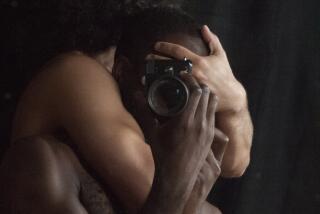EXHIBITS LEAVE BERNHARD LITTLE TIME FOR HER ART
- Share via
A surge in interest among gallery and museum directors in the work of Ruth Bernhard has left the 81-year-old photographer with little time to pursue her work.
“I haven’t been photographing very much lately,” Bernhard said in a recent interview at the Susan Spiritus Gallery in Newport Beach, where a selection of her work is on display through Jan. 10. “I’m more active now in printing and in getting my exhibitions out.”
During her more than 50-year career, Bernhard has gained recognition in photographic circles for her carefully constructed still lifes. She also has spent much of her career taking commissioned portraits in addition to her art photography, first in Los Angeles (she moved there from New York in 1936) and later in San Francisco, where she now lives.
But it is her sensitive photographic studies of female nudes that account largely for her recent success. An extensive display of Bernhard’s nudes (dating from 1934 to the present) recently closed at the San Francisco Museum of Modern Art and will move in February to New York’s International Center for Photography. The show shares the title of a new monograph of 50 Bernhard nudes, “The Eternal Body,” published by Photography West Graphics in Carmel. Last month, Bernhard traveled to Japan with an exhibit of her photographs.
Bernhard attributes her busy exhibit schedule to a lifelong aversion to saying no. “I always say yes to everything, because I always feel that whatever comes my way, life meant for me,” she explained. These days, that means Bernhard has to work overtime supplying prints for an ever-increasing number of exhibit requests.
It wasn’t always this way for Bernhard, who embarked on her career after moving to New York from Berlin in 1929. She started out as a darkroom assistant who looked on photography as a “mediocre craft” and credits a 1935 meeting with famed photographer Edward Weston with changing her view. “His artistry as a photographer made me have respect for my craft for the first time,” she explained. “It made me a serious photographer.”
While she has since enjoyed the recognition of her colleagues in the photographic community--including such seminal figures as Weston, Dorothea Lange, Imogen Cunningham and Ansel Adams (who was quoted as calling Bernhard “the greatest photographer of the nude”)--success with the general art audience has been slower in coming. “I think in the last 15 or 20 years I have been much more successful--that is, my name has been more successful,” Bernhard said.
A small woman whose energy and wit belie her age, Bernhard is known as a photographer who painstakingly crafts each image and takes but a single exposure. She rarely carries a camera outside her San Francisco studio, she said, because “that would make me feel as if I were seeking a picture, and I am always hoping that the picture speaks to me.”
Her photographic philosophy makes for a “very intuitive existence,” Bernhard admitted. “I don’t plan things; they plan for me. Photographs speak to me and I obey.”
She gave several examples, including the story of a crushed teapot she used in a well-known photograph. “I saw it lying in the street, and I scooped it up very fast--I was crossing against the red light as usual--and about a year later the teapot said, ‘Today is the day.’ And that was the day I photographed it,” Bernhard said. “So I never question when I’m supposed to make a photograph. That’s when I make it.”
Bernhard feels her intuitive approach clashes with what she sees as the more calculated working methods of some contemporary photographers. “I feel that everything has to come from the heart, and it cannot come from the intellect,” she explained. “I see a great deal of work that is completely disconnected from the life of the person, and that does not speak to me. . . . I want to see in somebody’s work the kind of person they are; I don’t want to have to read about them.”
Emphasizing philosophy over technique, Bernhard imparts her approach to her art through numerous workshops, including annual participation in the Ansel Adams Workshops in Carmel. “I feel that is more important than my work, the influence I have on my students,” said Bernhard, who, as usual, finds it hard to say no to an invitation to teach.
Because of the current retrospectives of her works and preparation of her recent book (another book by the same publisher may be forthcoming), Bernhard has recently been spending a great deal of time with photographs from all points in her career. And she has found that time has not diminished the attachment to her early efforts.
“My early work is so true to me,” Bernhard said. “My attitude and my reasons for photographing haven’t changed.
“It’s very difficult to look back because it was all just now. I don’t have a feeling that something was at any other time; I have a feeling that the time is now.”
More to Read
The biggest entertainment stories
Get our big stories about Hollywood, film, television, music, arts, culture and more right in your inbox as soon as they publish.
You may occasionally receive promotional content from the Los Angeles Times.










